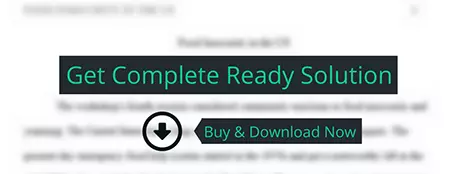Public Provision of Goods and Services As of 2016, about one-quarter of all vehicle miles driven in the country use the Interstate Highway System.
accounting
Description
Please
provide answers in ONE Word
file, starting a NEW PAGE for
each question. Also, for question 2, you will construct a table in Excel and
submit ONE Excel file.
(Put all your text answers in the single Word file; the Excel file will be just
for the table.)
You
need not include the questions along with your answers. That is, you don’t need
to start with this Word file and type in answers following each question; you
can start a NEW Word file and just
provide your answers. However, please be sure to label each answer with the
appropriate question number, e.g. Question 1-(1).
Wherever
you are providing answers in dollars, please be sure to clearly label whether
your answer is in dollars, or in millions, billions, or trillions of dollars.
1.
(3 points) Public Provision of Goods and
Services
As of 2016, about one-quarter of all vehicle miles
driven in the country use the Interstate Highway System. Interstate highways
and their rights of way are owned by the state in which they were built, but
the federal government pays roughly one half of the construction costs. About
70 percent of the overall construction and maintenance costs are paid for by
fuel taxes collected by the federal, state, and local governments.
(1) What are
the reasons for the governmental as opposed to private provision of interstate
highways?
(2) What is the rationale for using fuel taxes as
opposed to general revenue to fund highways?
(3) Since the states own the highways, what are the
justifications for the division of responsibilities that the federal government
pays half of the construction costs?
Be sure to apply the economic theories we
discussed in class. Limit your answers to no more than one single-spaced page.
2.
(4
points) Discretionary Spending Baseline Analysis
Suppose
that the Congress is considering the creation of a new education grant program
aimed at addressing learning disability issues at the state and local level.
The program would be funded through annual appropriations, with the money
transferred to states through a population-based formula by the Department of
Education. The proposal is to appropriate $650
million for fiscal year 2021.
Your
boss on the Senate Budget Committee has asked you to create a hypothetical
10-year baseline projection for the program, covering estimated costs for
fiscal years 2021 through 2030. (Note:
Since this is a brand-new program and 2021 will be the first year of
appropriation, there are no “outlay priors” to worry about.)
There
is no history to rely on since this will be a brand-new program. However, the
proposed grant program seems similar to a few other education programs that you
are familiar with, so you think you can use historical spending patterns for
those similar programs to help create the baseline projection. You have
identified historical average spendout rates to use for estimating outlays from
new funding for the grants:
·
24 percent in the first year,
·
71 percent in the second year,
·
4 percent in the third year, and
·
1 percent remaining unspent (and
eventually lapsing)
To
inflate appropriations, assume that the baseline will reflect anticipated
inflation of 2% per year.
(1)
Create a “waterfall table” for fiscal
years of 2021 through 2030 using the above information. Create your spreadsheet
table in an Excel worksheet that clearly shows all your work for each year, including
showing the formulas—in other words, don’t create a table with just the end-product numbers.
(2)
How much appropriation would be required
in total under the 10-year baseline for the grants program? That is, what is
the 10-year total of baseline budget authority? (Respond in your Word
document.)
(3)
What are the first-year (2021) outlays
and the subtotal of the first three years (2021-2023) outlays? (Respond in your
Word document.)
3. (3 points) CBO Cost Estimate
On
April 22, 2019, CBO published a cost estimate for House Bill 582, Raise the
Wage Act. You can obtain a copy of the report here.
Read the report and answer the following questions.
(1) In
your own word, why does raising the federal minimum wage DIRECTLY affect the
federal budget?
(2) Would
the proposed policy have an impact on mandatory spending, and why? If yes, by
how much does it change the projected federal deficit associated with mandatory
spending over the 2020-2029 period?







